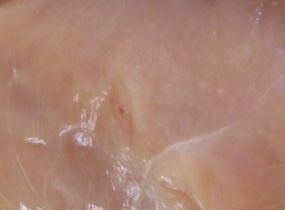Tracing Listeria monocytogenes in commercial chicken plant

Incoming raw poultry is the primary source of Listeria monocytogenes contamination in commercial chicken cooking plants, according to a 21-month study conducted by Agricultural Research Service (ARS) scientists and their collaborators at the University of Georgia.
The study’s results will help these facilities more sharply focus their sanitation processes to reduce cross-contamination. L. monocytogenes is a bacterial human pathogen that is sometimes found in fully cooked, ready-to-eat processed meat and poultry products.
By testing a brand-new commercial cooking facility before and after processing began, the research team was able to track sources of contamination. The research team was led by ARS microbiologist Mark Berrang of the Bacterial Epidemiology and Antimicrobial Resistance Research Unit at the agency’s Richard B. Russell Research Center in Athens, Ga, US.
Because the pathogen is prevalent in the environment and in various forms, there were several potential sources of contamination, including employees, incoming fresh air, raw meat and the surrounding environment.
Potential sources of L. monocytogenes were tested by taking samples of soil and water around and near the facility exterior, and by testing heavily traveled floor surfaces following personnel shift changes. Samples were also collected and tested from incoming air from air vent filters and from monthly swabs of incoming raw meat. The plant was free of L. monocytogenes when first constructed; floor drains in the facility were sampled approximately monthly to determine at what point the plant would become colonized with the bacteria.
Within 4 months of operation, L. monocytogenes was detected in floor drains, indicating that the organism had been introduced from some outside source. No L. monocytogenes was recovered from any floor samples in the plant entryways, locker room or cafeteria. Likewise, the organism was not detected on air vent filters during the survey. The only tested source found to be consistently positive for L. monocytogenes was incoming raw poultry meat.
Quality assurance in the test plant was exceptional and included an extensive proactive sampling plan to assure food safety. L. monocytogenes can become prevalent in food processing environments; sanitation, biosafety and product sampling protocols are in place in these facilities to prevent shipping contaminated product.
This research was reported in the Journal of Food Protection. Co-authors included ARS microbiologist Richard Meinersmann in Athens, University of Georgia scientist Joseph Frank, and former ARS researcher Scott Ladely.
Source: ARS, the principal intramural scientific research agency of the U.S. Department of Agriculture (USDA)












